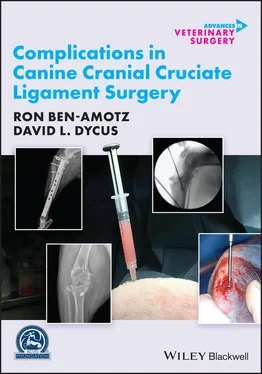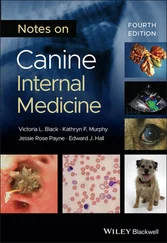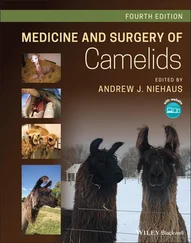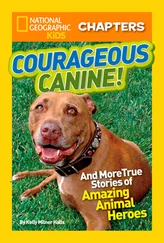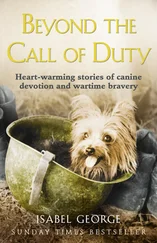34 34. Thompson, A.M., Bergh, M.S., Wang, C., and Wells, K. (2011). Tibial plateau levelling osteotomy implant removal: a retrospective analysis of 129 cases. Vet. Comp. Orthop. Traumatol. 24: 450–456.
35 35. van Rijen, M., Bonten, M., Wenzel, R., and Kluytmans, J. (2008). Intranasal mupirocin for reduction of Staphylococcus aureus infections in surgical patients with nasal carriage: a systematic review. J. Antimicrob. Chemother. 61 (2): 254–261.
36 36. Thompson, P. and Houston, S. (2013). Decreasing methicillin‐resistant Staphylococcus aureus surgical site infections with chlorhexidine and mupirocin. Am. J. Infect. Control. 41 (7): 629–633.
37 37. Rao, N., Cannella, B., Crossett, L. et al. (2011). Preoperative screening/decolonization for Staphylococcus aureus to prevent orthopedic surgical site infection: prospective cohort study with 2‐year follow‐up. J. Arthroplasty 26 (8): 1501–1507.
38 38. Courville, X., Tomek, I., Kirkland, K. et al. (2012). Cost‐effectiveness of preoperative nasal mupirocin treatment in preventing surgical site infection in patients undergoing total hip and knee arthroplasty: a cost‐effectiveness analysis. Infect. Control Hosp. Epidemiol. 33 (2): 152–159.
39 39. Diribe, O., Thomas, S., AbuOun, M. et al. (2015). Genotypic relatedness and characterization of Staphylococcus pseudintermedius associated with post‐operative surgical infections in dogs. J. Med. Microbiol. 64: 1074–1081.
40 40. Borio, S., Colombo, S., La Rosa, G. et al. (2015). Effectiveness of a combined (4% chlorhexidine digluconate shampoo and solution) protocol in MRS and non‐MRS canine superficial pyoderma: a randomized, blinded, antibiotic‐controlled study. Vet. Dermatol. 26: 339–e72.
41 41. Mayhew, P.D., Freeman, L., Kwan, T., and Brown, D.C. (2012). Comparison of surgical site infection rates in clean and clean‐contaminated wounds in dogs and cats after minimally invasive versus open surgery: 179 cases (2007–2008). J. Am. Vet. Med. Assoc. 240 (2): 193–198.
42 42. Brown, D.C., Conzemius, M., Shofer, F., and Swann, H. (1997). Epidemiologic evaluation of postoperative wound infections in dogs and cats. J. Am. Vet. Med. Assoc. 210 (9): 1302–1306.
43 43. Berrios‐Torres, S., Umscheid, C., Bratzler, D. et al. (2017). Centers for Disease Control and Prevention guideline for the prevention of surgical site infection. J. Am. Med. Assoc. Surg. 152 (8): 784–791.
44 44. World Health Organization (2016). Global Guidelines for the Prevention of Surgical Site Infection. Geneva: WHO.
45 45. Belo, L., Serrano, I., Cunha, E. et al. (2018). Skin asepsis protocols as a preventive measure of surgical site infections in dogs: chlorhexidine – alcohol versus povidone‐iodine. BMC Vet. Res. 14 (95): 1–6.
46 46. Melekwe, G.O., Uwagie‐Ero, E.A., Zoaka, H.A., and Odigie, E.A. (2018). Comparative clinical effectiveness of preoperative skin antiseptic preparations of chlorhexidine gluconate and povidone iodine for preventing surgical site infections in dogs. Int. J. Vet. Sci. Med. 6 (1): 113–116.
47 47. Andrade, N., Schmiedt, C.W., Cornell, K. et al. (2016). Survey of intraoperative bacterial contamination in dogs undergoing elective orthopedic surgery. Vet. Surg. 45: 214–222.
48 48. Straw, R.C., Tomlinson, J.L., and Fales, W.H. (1987). Scalpel blade contamination with skin bacteria during orthopedic and neurosurgical procedures in dogs. Vet. Surg. 16: 25–30.
49 49. Lioce, C.G., Davis, E.C., Bennett, J.W. et al. (2019). Scalpel blade contamination and risk of postoperative surgical site infection following abdominal incisions in dogs. BMC Res. Notes 12: 459.
50 50. Belo, L., Serrano, I., Cunha, E. et al. (2020). Surgical blades as bacteria dissemination vehicles in dogs undergoing surgery −a pilot study. Biomed. Eng. Int. 2 (1): 25–29.
51 51. Sturgeon, C., Lamport, A.I., Lloyd, D.H., and Muir, P. (2000). Bacterial contamination of suction tips used during surgical procedures performed on dogs and cats. Am. J. Vet. Res. 61 (7): 779–783.
52 52. Medl, N., Guerrero, T.G., Holzle, L. et al. (2012). Intraoperative contamination of the suction tip in clean orthopedic surgeries in dogs and cats. Vet. Surg. 41: 254–260.
53 53. Weese, J.S. (2008). A review of post‐operative infections in veterinary orthopaedic surgery. Vet. Comp. Orthop. Traumatol. 21: 99–105.
54 54. Feßler, A.T., Schuenemann, R., Kadlec, K. et al. (2018). Methicillin‐resistant Staphylococcus aureus (MRSA) and methicillin‐resistant Staphylococcus pseudintermedius (MRSP) among employees and in the environment of a small animal hospital. Vet. Microbiol. 221: 153–158.
55 55. Larson, E. (1995). APIC guidelines for handwashing and hand antisepsis in health care settings. Am. J. Infect. Control 23 (4): 251–269.
56 56. Verwilghen, D.R., Mainil, J., Mastrocicco, E. et al. (2011). Surgical hand antisepsis in veterinary practice: evaluation of soap scrubs and alcohol based rub techniques. Vet. J. 190 (3): 372–377.
57 57. Parienti, J.J., Thibon, P., Heller, R. et al. (2002). Hand‐rubbing with an aqueous alcoholic solution vs traditional surgical hand‐scrubbing and 30‐day surgical site infection rates. J. Am. Med. Assoc. 288 (6): 722–727.
58 58. Hingst, V., Juditzki, I., Heeg, P., and Sonntag, H.‐G. (1992). Evaluation of the efficacy of surgical hand disinfection following a reduced application time of 3 instead of 5 minutes. J. Hosp. Infect. 20 (2): 79–86.
59 59. Verwilghen, D. and Kampf, G. (2016). Letter to the editor: antibacterial efficacy of several surgical hand preparation products used by veterinary students. Vet. Surg. 45: 1118–1119.
60 60. Hübner, N., Kampf, G., Kamp, P. et al. (2006). Does a preceding hand wash and drying time after surgical hand disinfection influence the efficacy of a propanol‐based hand rub? BMC Microbiol. 6: 57.
61 61. Widmer, A.F., Rotter, M., Voss, A. et al. (2010). Surgical hand preparation: state‐of‐the‐art. J. Hosp. Infect. 74 (2): 112–122.
62 62. Meakin, L.B., Gilman, O.P., Parsons, K.J. et al. (2016). Colored indicator undergloves increase the detection of glove perforations by surgeons during small animal orthopedic surgery: a randomized controlled trial. Vet. Surg. 45: 709–714.
63 63. Hayes, G.M., Reynolds, D., Moens, N.M.M. et al. (2014). Investigation of incidence and risk factors for surgical glove perforation in small animal surgery. Vet. Surg. 43: 400–404.
64 64. Stine, S.L., Odum, S.M., and Daniel Mertens, W. (2018). Protocol changes to reduce implant‐associated infection rate after tibial plateau leveling osteotomy: 703 dogs, 811 TPLO (2006–2014). Vet. Surg. 47: 481–489.
65 65. Boothe, H.W. (2017). Instrument and tissue handling techniques. In: Veterinary Surgery, 2e (eds. S.A. Johnston and K.M. Tobias), 733. St Louis, MO: Elsevier.
66 66. Cadman, C. (2016). The impact of surgical safety checklists on theatre departments: a critical review of the literature. J. Perioper. Pract. 26 (4): 62–71.
67 67. Haynes, A., Weiser, T., Berry, W. et al. (2009). A surgical safety checklist to reduce morbidity and mortality in a global population. N. Engl. J. Med. 360: 491–499.
68 68. Verwilghen, D. and Singh, A. (2015). Fighting surgical site infections in small animals: are we getting anywhere? Vet. Clin. North Am. Small Anim. Pract. 45 (2): 243–276.
69 69. Gatineau, M., El‐warrak, A.O., Bolliger, C. et al. (2012). Effects of sterilization with hydrogen peroxide gas plasma, ethylene oxide, and steam on bioadhesive properties of nylon and polyethylene lines used for stabilization of canine stifle joints. Am. J. Vet. Res. 73: 1665–1659.
70 70. Solano, M.A., Danielski, A., Kovach, K. et al. (2015). Locking plate and screw fixation after tibial plateau leveling osteotomy reduces postoperative infection rate in dogs over 50 kg. Vet. Surg. 44: 59–64.
Читать дальше
